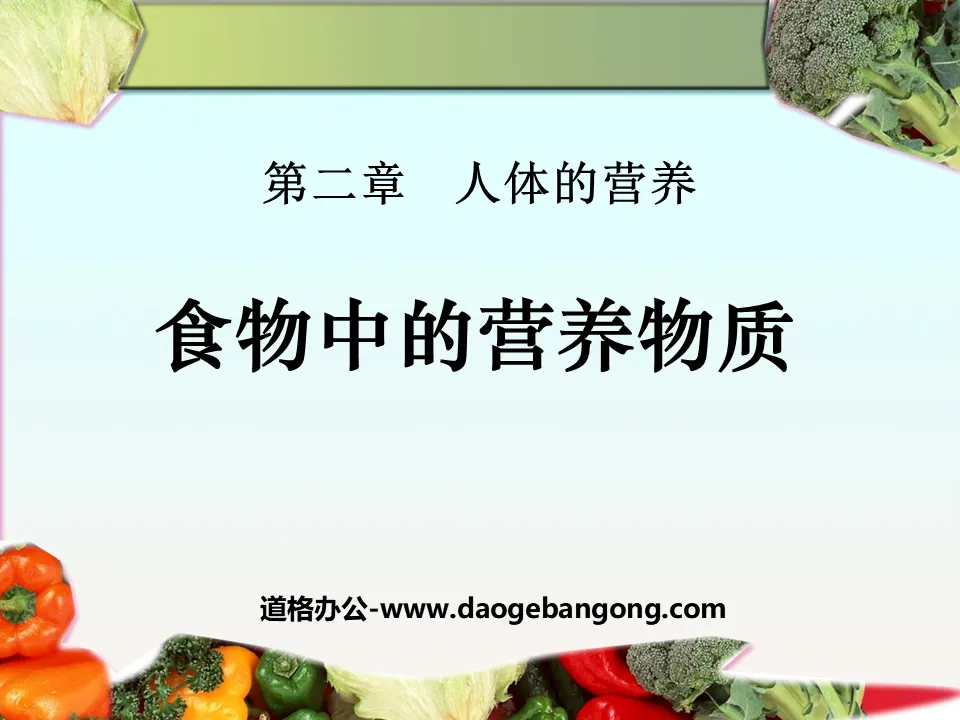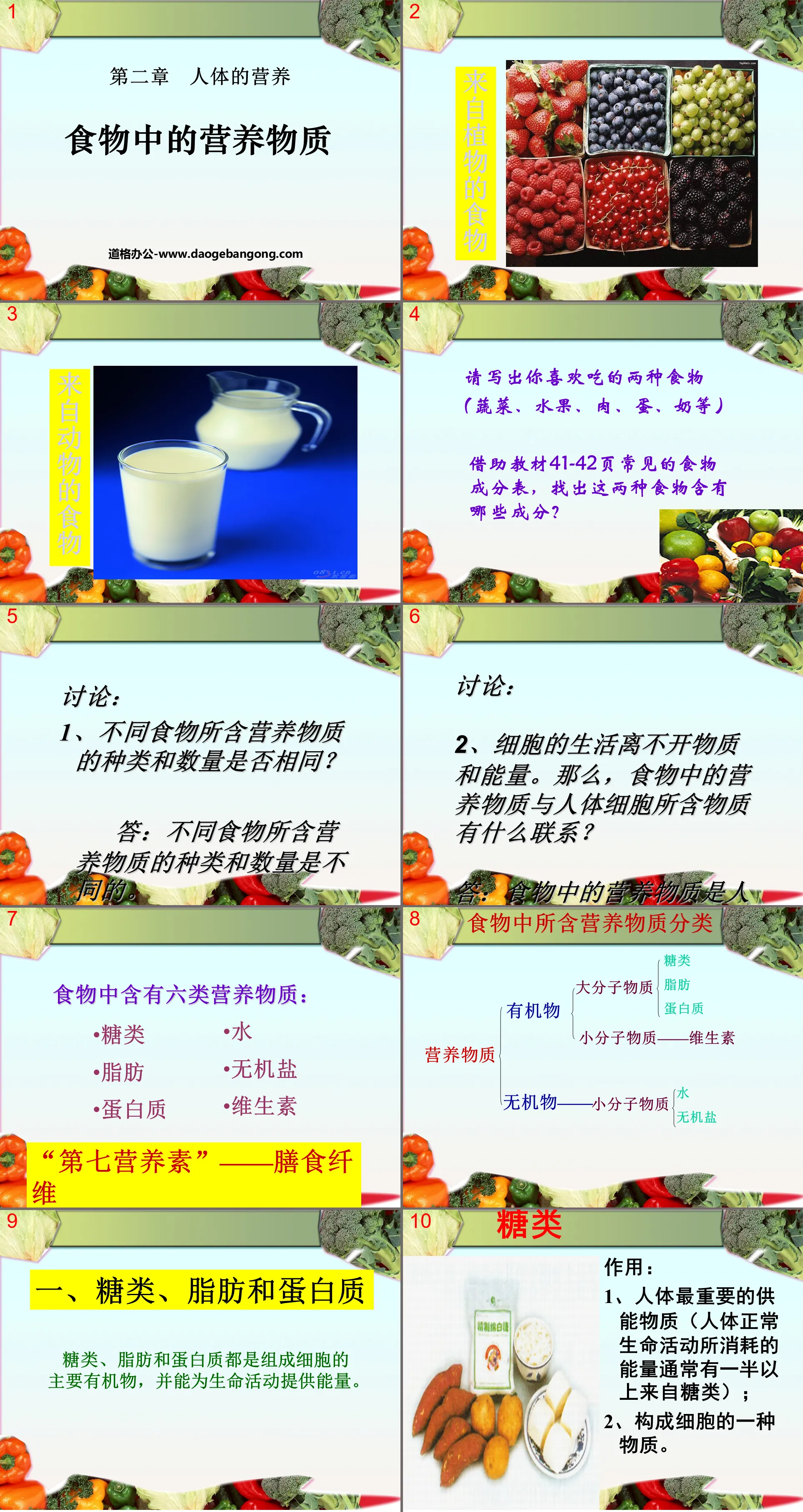People's Education Edition Biology for Grade 8, Volume 1
People's Education Edition seventh grade biology volume 1
People's Education Edition Biology for Grade 8, Volume 2
People's Education Press High School Biology Compulsory Course 2
Beijing Normal University Edition Seventh Grade Biology Volume 2
People's Education Press seventh grade biology book volume 2
Beijing Normal University Edition Eighth Grade Biology Volume 2
Beijing Normal University Edition Seventh Grade Biology Volume 1
Beijing Normal University Edition Eighth Grade Biology Volume 1
High School Biology Compulsory Course 1, published by People's Education Press
Jiangsu Education Edition Seventh Grade Biology Volume 1
Jiangsu Education Edition 8th Grade Biology Volume 1
Jiangsu Education Edition Seventh Grade Biology Volume 2
Jiangsu Education Edition 8th Grade Biology Volume 2

| Category | Format | Size |
|---|---|---|
| People's Education Press seventh grade biology book volume 2 | pptx | 6 MB |
Description
"Nutrition Substances in Food" Human Nutrition PPT Courseware 5
Please write down two foods you like to eat
(Vegetables, fruits, meat, eggs, milk, etc.)
With the help of the common food ingredient lists on pages 41-42 of the textbook, find out what ingredients are contained in these two foods?
discuss:
1. Do different foods contain the same types and amounts of nutrients?
Answer: Different foods contain different types and amounts of nutrients.
2. Cell life cannot be separated from matter and energy. So, what is the connection between the nutrients in food and the substances contained in human cells?
Answer: Nutrients in food are the source of substances contained in human cells.
1. Carbohydrates, fats and proteins
Carbohydrates, fats and proteins are the main organic compounds that make up cells and can provide energy for life activities.
carbohydrate
effect:
1. The most important energy supply substance for the human body (more than half of the energy consumed by normal life activities of the human body usually comes from sugar);
2. A substance that constitutes cells.
When patients cannot eat normally, they often need intravenous drips of glucose because glucose can provide energy to the body.
Fat
effect:
1. An important substance that provides energy, but is often stored in the body as a backup energy substance.
2. Components that make up cells.
Generally, adults store about 10 to 20% of body mass in fat, which is a backup energy source for maintaining life activities. When a person eats a small amount and the energy in the food intake is not enough to cover the body's consumption, he will consume his own fat to meet the body's needs. At this time, the person will lose weight.
Make assumptions:
Making assumptions needs to be based on existing knowledge and experience. The assumptions made for different questions are different. Some questions may not require assumptions, such as measuring the germination rate of seeds. Before measuring, there is no need to put forward an assumed value for the germination rate of seeds.
hint
The energy in food can be determined by measuring how much heat energy is released when the food is burned.
The food you choose should be easy to burn, such as peanut seeds, walnut seeds, etc.
For every 1 ml of water to rise by 1°C, it needs to absorb 4.2 joules of heat energy.
Experimental steps:
1. In the center of the top of the empty can, cut a round hole slightly larger than the mouth of the conical bottle. Cut several holes around the round hole and around the bottom of the can to facilitate ventilation.
2. Take an Erlenmeyer flask (50 ml), pour 30 ml of water, and put in a thermometer (the lower end of the thermometer should be immersed in water).
3. Refer to the picture on the right to install the experimental device and measure the water temperature.
4. Weigh a dry peanut seed and place the seed on a flame to burn.
5. Place the newly burned peanut seeds at the bottom of the Erlenmeyer flask as soon as possible. After the peanut seeds are completely burned, measure the water temperature.
Think about it:
1. Is it necessary to use empty cans in the experimental device?
2. How can we minimize the loss of energy during the combustion of peanut seeds?
discuss
1. Is your data the same as the data in the appendix on pages 41~42 and the data of your classmates? If different, analyze the possible reasons.
Answer: If they are different, the possible reasons are: the experimental operation is not standardized enough, the measurement is not accurate enough, or there is an error in the calculation, etc.
2. This research experiment is only done once. Is the result reliable? What should be done?
Answer: The research experiment is only done once, and errors may occur, so the results are unreliable. It should be repeated three times with all conditions being the same, and the average of these three times should be taken to minimize the impact of errors.
Exploration experiment
Compare the vitamin C content in different vegetables or fruits
Experimental principle: The aqueous solution of vitamin C can discolor the potassium permanganate solution, and the more concentrated the vitamin C solution, the less the dosage.
Experimental steps
1. Choose any two fresh vegetables or fruits that are commonly eaten locally, put the vegetables or fruits into a mortar and squeeze out the juice or use a juicer to squeeze out the juice. Pour the two juices into two clean, dry small beakers.
2. Take 2 clean, dry small test tubes and inject 2 ml of potassium permanganate solution of the same concentration into each.
3. Take a clean, dry dropper, absorb the first juice, and gradually drip it into a small test tube. While dripping, shaking, and observing, until the potassium permanganate solution loses color, record the juice. number of drops.
4. Refer to the above method, use the above-mentioned dropper to test the second juice, record the number of drops of juice and compare it with the number of drops of the first juice to draw a conclusion.
Note: For accurate comparison, the same dropper should be used for both solutions. Before using this dropper to drop the second juice, you need to wash the dropper with clean water and use absorbent paper to absorb the moisture inside and outside the dropper.
Conclusion: The more drops of juice used, the lower the vitamin C content of the fruit or vegetable; the fewer drops of juice used, the higher the vitamin C content of the fruit or vegetable.
Keywords: Human body nutrition teaching courseware, Nutrients in food teaching courseware, New People’s Education Edition seventh grade biology PPT courseware, Volume 2, seventh grade biology slide courseware download, Human body nutrition PPT courseware download, Nutrients in food PPT Courseware download, .ppt format
For more information about the PPT courseware "Nutrient Substances in Food for the Human Body", please click on the Nutrient Substances in Food ppt tab for the Nutrient Substances in the Food for the Human Body.
"Nutrition Substances in Food" Chemistry and Social Life PPT Courseware 4:
"Nutrition Substances in Food" Chemistry and Social Life PPT Courseware 4 Knowledge Network Nutrients in food The role of sugars in the human body: The main source of energy in the human body The properties of common sugars and the classification of food sources oils and fats The role of fats and oils in the human body : human body..
"Nutrition Substances in Food" Chemistry and Social Life PPT Courseware 3:
"Nutrition Substances in Food" Chemistry and Social Life PPT Courseware 3 Learning Objectives 1. Understand the main nutrients contained in food; 2. Understand the sources of various nutrients and their effects on the human body. 3. Understand the sources and deficiencies of inorganic salts and vitamins; focus...
"Nutrition Substances in Food" Chemistry and Social Life PPT Courseware 2:
"Nutrition Substances in Food" Chemistry and Social Life PPT Courseware 2 Learning Objectives 1. Be able to tell what nutrients are in food that are necessary for the human body. 2. Name the main functions of various nutrients. 3. Use scientific inquiry methods to determine the energy in food. 4.Identify people...
File Info
Update Time: 2024-11-24
This template belongs to biology courseware People's Education Press seventh grade biology book volume 2 industry PPT template
"Nutrition Substances in Food" Human Nutrition PPT Courseware 5 Simple campus recruitment activity planning plan summary enterprise and institution recruitment publicity lecture PPT template is a general PPT template for business post competition provided by the manuscript PPT, simple campus recruitment activity planning plan summary enterprise and institution recruitment promotion Lecture PPT template, you can edit and modify the text and pictures in the source file by downloading the source file. If you want more exquisite business PPT templates, you can come to grid resource. Doug resource PPT, massive PPT template slide material download, we only make high-quality PPT templates!
Tips: If you open the template and feel that it is not suitable for all your needs, you can search for related content "Nutrition Substances in Food" Human Nutrition PPT Courseware 5 is enough.
How to use the Windows system template
Directly decompress the file and use it with office or wps
How to use the Mac system template
Directly decompress the file and use it Office or wps can be used
Related reading
For more detailed PPT-related tutorials and font tutorials, you can view: Click to see
How to create a high-quality technological sense PPT? 4 ways to share the bottom of the box
Notice
Do not download in WeChat, Zhihu, QQ, built-in browsers, please use mobile browsers to download! If you are a mobile phone user, please download it on your computer!
1. The manuscript PPT is only for study and reference, please delete it 24 hours after downloading.
2. If the resource involves your legitimate rights and interests, delete it immediately.
3. Contact information: service@daogebangong.com
"Nutrition Substances in Food" Human Nutrition PPT Courseware 5, due to usage restrictions, it is only for personal study and reference use. For commercial use, please go to the relevant official website for authorization.
(Personal non-commercial use refers to the use of this font to complete the display of personal works, including but not limited to the design of personal papers, resumes, etc.)
Preview










